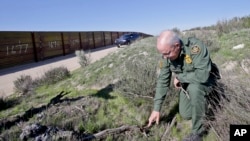You see it a lot in the movies, but mantracking — the art of following another person through wild terrain by interpreting clues left in their wake — isn’t only Hollywood make-believe.
The first investigative tool man ever used is still relevant today, and has potential to make a real difference when used to find lost children, hunters and Alzheimer’s patients who’ve wandered off, according to Jamison Peevyhouse.
The emergency management director for a rural county in western Tennessee recently attended a mantracking class for beginners offered by the Forensic Institute for Research and Education at Middle Tennessee State University.
“[They're] on the scene first,” he said. “And while everybody else is trying to glean information from parents and bystanders, these six-person or eight-person teams will be out there searching the area trying to find where the track is actually at.”
Peevyhouse was one of the 20 or so mantracking students who marched into the woods for their first exercise one morning. Most were already looking a little lost. They lined up in two rows an arms' length apart and their instructor, Master Tracker Levi Montgomery, walked between them, leaving footprints in the path.
They watched closely as his boots hit the ground in front of them. But when Montgomery asked them to point out some sign of his passing, they had trouble seeing any evidence of it among the leaves, twigs and weeds at their feet.
With a shake of his head, Montgomery said, “I’ve had several come up to me and say, 'I see where you’re pointing, but I don’t see anything.' I remember those days. I thought the instructor was pulling my leg, saying, ‘Look. It’s right there in front of you,’ and his finger is touching it, and I’m saying ‘I don’t see anything.’”
Understanding what you see
Most novices expect to see actual footprints, but Montgomery says that’s rare. He explains that wildland tracking is about noticing and interpreting the tiniest of clues: a broken twig, a disturbed pebble, or maybe an overturned leaf. It requires practice and patience, "slowing my brain down enough and relax from inner city living and get out into the country and actually start determining the disturbance in the ground.”
A couple of hours into the class, things are going better, perhaps because the students have now been divided into four-person tracking teams. The team leader focuses on the small clues left by each step. Flankers roam to either side to ensure the direction of travel hasn’t changed. The rear observer looks down the trail for more obvious signs of passage.
Among their tools are poles and rubber bands, used to measure the stride between tracked steps. They move the rubber bands up or down the pole to mark the distance between steps. Then, if they are having trouble seeing the next step, they use the stick to estimate the arc in which it likely fell.
Hugh Berryman, director of the Forensic Institute for Research and Education at Middle Tennessee State University, a master tracker, is hosting today’s class. Tracking is usually referred to as an art, but Berryman believes it will someday be a science.
“There’s certain things that we use in tracking to determine how long it’s been since a person passed a certain area," he explained. "It has to do with insect activity, it has to do with plants and the way plants respond to damage, color changes and things like that. And I think there’s all sorts of opportunities for research projects in that.”
Whether art or science, the mantracking classes are proving popular with law enforcement officers, emergency management officials, forensic students and with the general public. Berryman and the Forensic Institute plan to conduct four training sessions each year.





